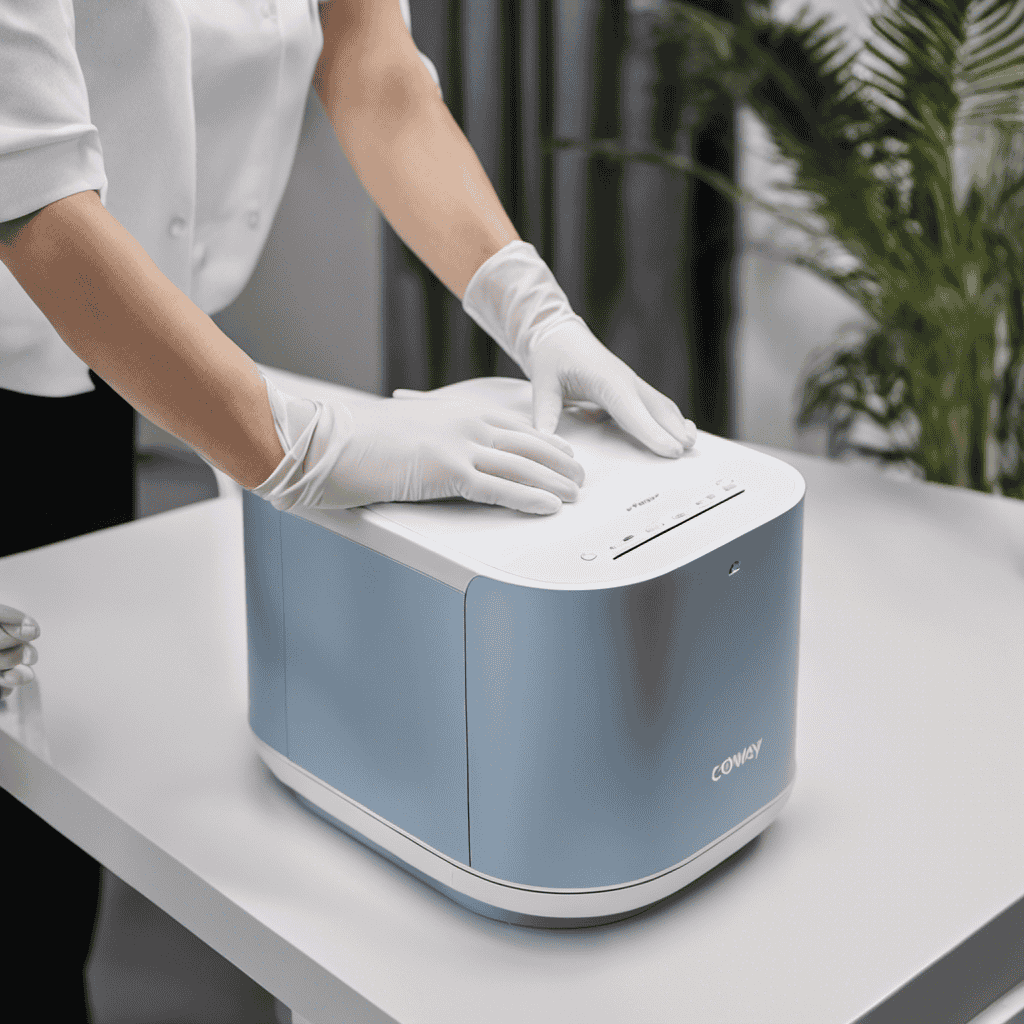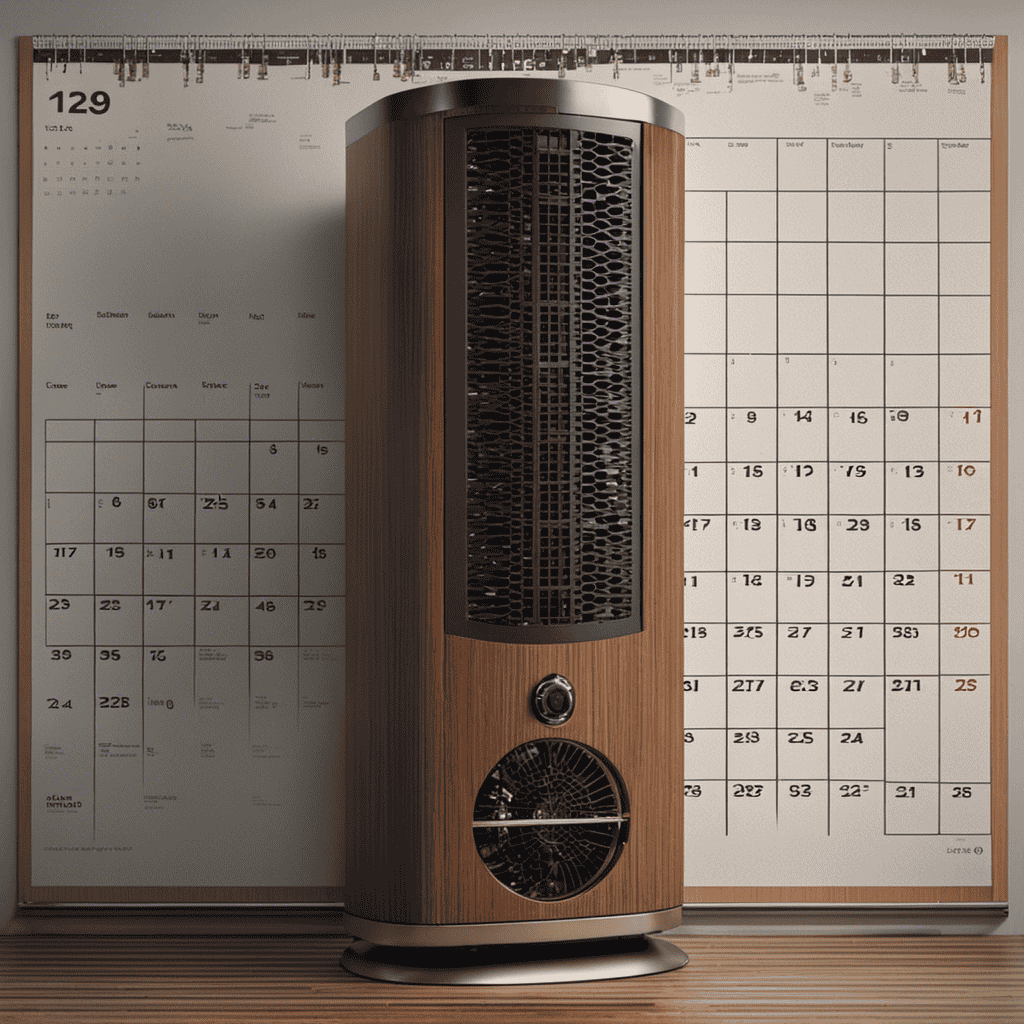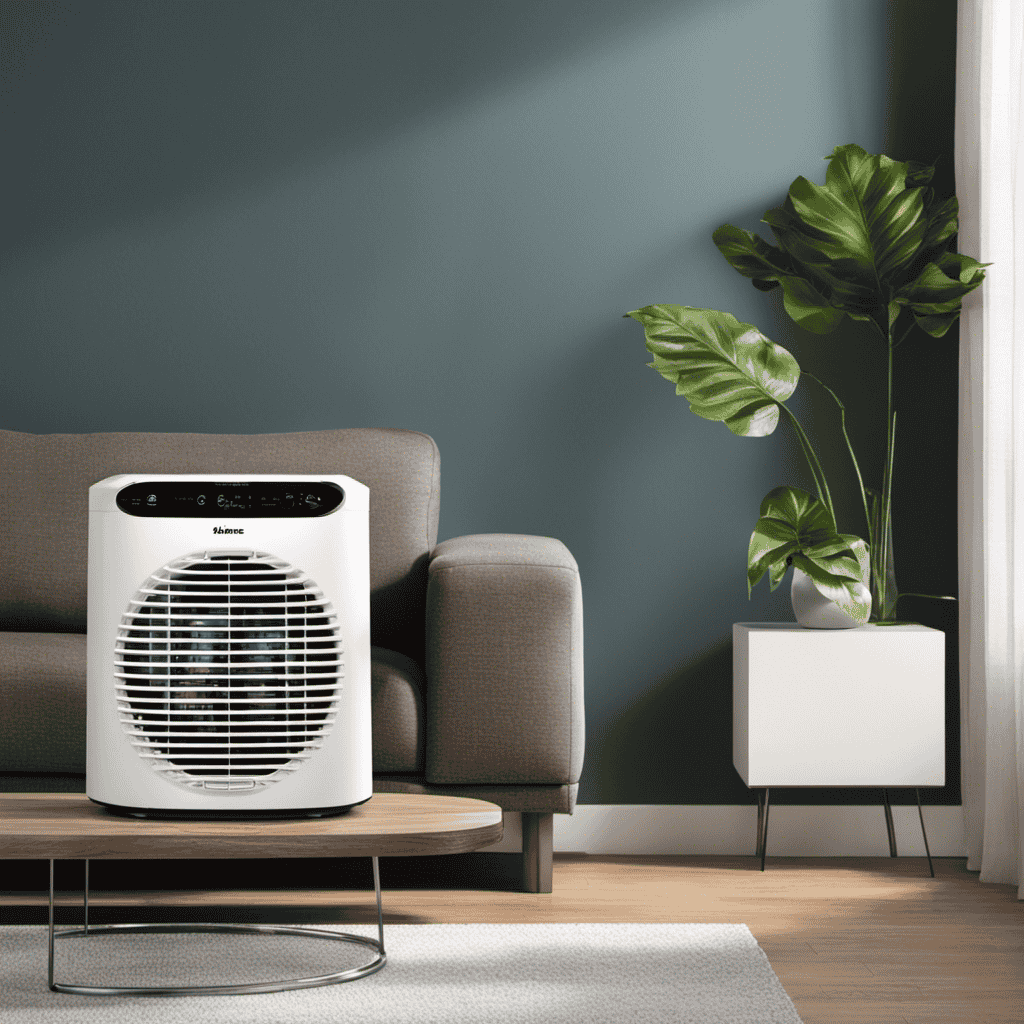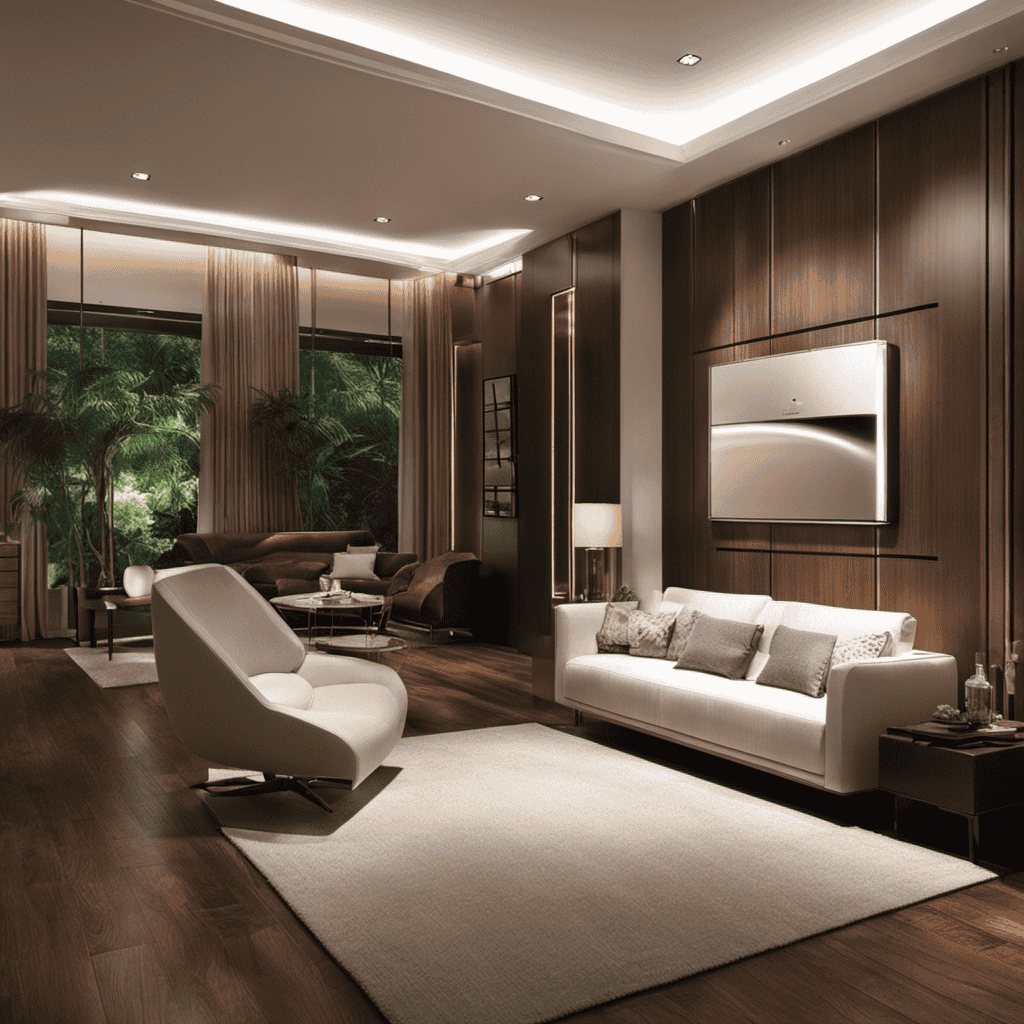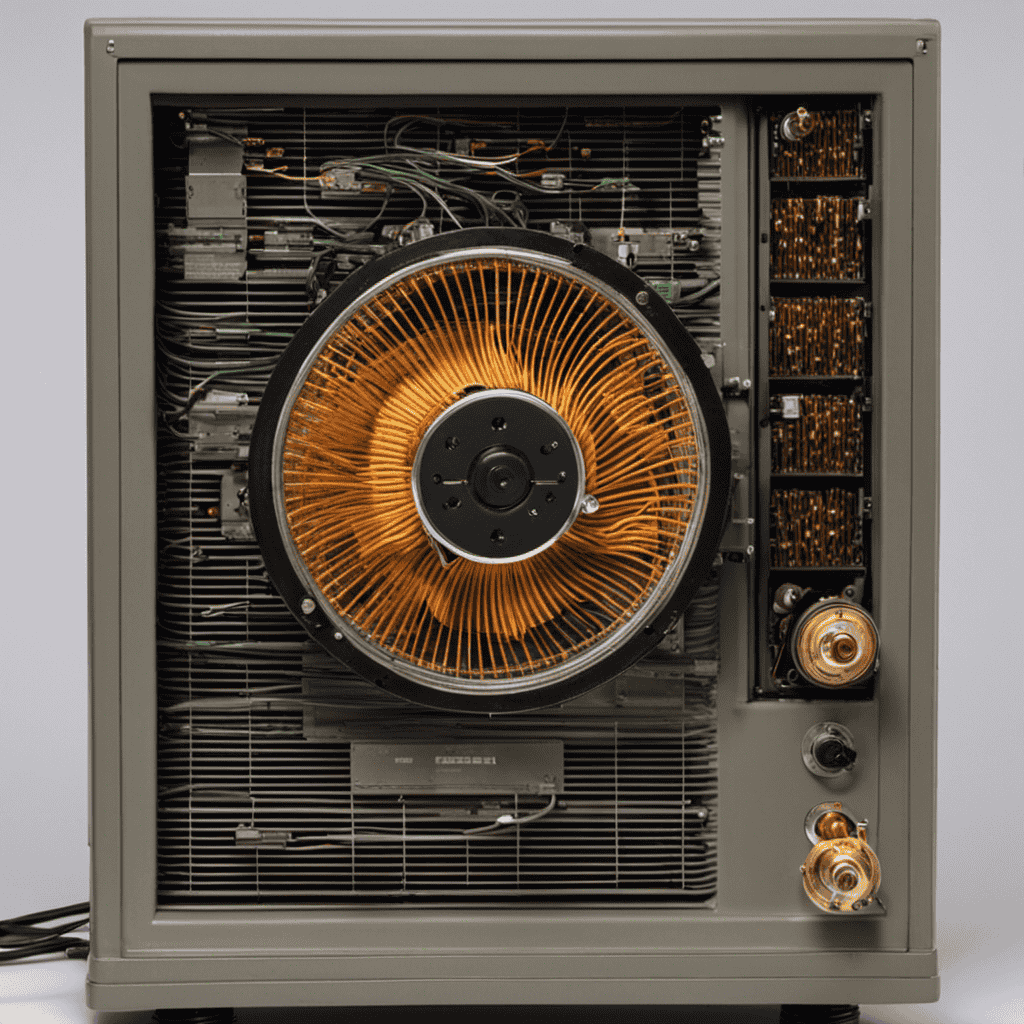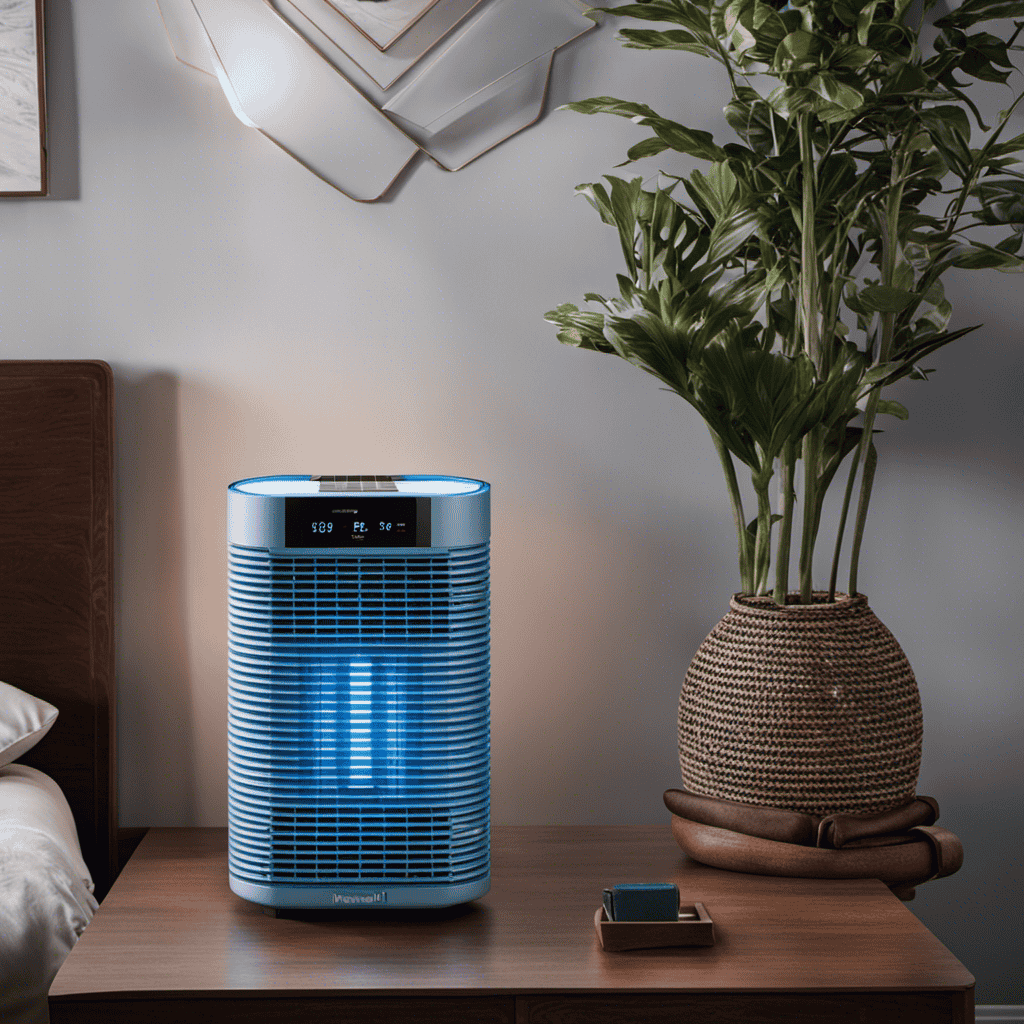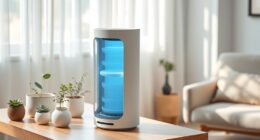I have always been curious about the correct way to clean my Coway air purifier. It is a vital device in my household, and I want to ensure that it is operating at its peak performance.
After conducting thorough research and testing different methods, I’ve finally discovered the most effective way to clean this innovative device. In this article, I will share my knowledge and provide step-by-step instructions on how to clean the filters, exterior surfaces, sensor and control panel, as well as the air vents.
Get ready to learn how to maintain your Coway air purifier for optimal performance!
Key Takeaways
- Regular cleaning is important for maintaining the effectiveness and efficiency of the Coway air purifier.
- Cleaning the filters every 3-6 months and following the manufacturer’s guidelines for filter replacement is crucial for optimal performance and air quality.
- The exterior surfaces, sensor and control panel, and air vents should be regularly cleaned using mild soap and water solution to ensure proper maintenance.
- Regular maintenance, including filter replacement and cleaning, prolongs the lifespan of the air purifier and provides a healthier living environment.
Importance of Regular Cleaning
You should make sure to regularly clean your Coway air purifier to maintain its effectiveness. The importance of maintenance cannot be overstated when it comes to air purifiers.
Regular cleaning ensures that your purifier continues to function optimally and provide you with clean and fresh air. By cleaning your air purifier on a regular basis, you can remove any accumulated dust, pet dander, pollen, and other pollutants that may have been trapped in the filters. This helps to maintain the airflow and efficiency of the purifier, ensuring that it can effectively remove contaminants from the air in your home.
Additionally, regular cleaning also prolongs the lifespan of your Coway air purifier, saving you money in the long run. So, make it a habit to clean your air purifier regularly to enjoy the benefits of cleaner air and a healthier living environment.
Understanding the Cleaning Process
When it comes to maintaining a clean and healthy living environment, understanding the cleaning process is crucial.
Two key factors to consider are the cleaning frequency and schedule, as well as the recommended cleaning techniques.
Cleaning Frequency and Schedule
The recommended cleaning frequency for the Coway air purifier is once every three months. Regular cleaning ensures optimal performance and extends the lifespan of your air purifier. Here are some tips to help you maintain the cleaning efficiency of your Coway air purifier:
-
Use gentle cleaning products: Avoid using harsh chemicals or abrasive cleaners that can damage the filters or the internals of the purifier. Stick to mild, non-toxic cleaning solutions recommended by the manufacturer.
-
Clean the pre-filter regularly: The pre-filter captures larger particles like dust and pet hair. Gently vacuum or rinse the pre-filter once a month to remove accumulated debris and maintain its effectiveness.
-
Replace the filters as needed: Depending on the model, Coway air purifiers have different filter types, such as HEPA, activated carbon, and ionizers. Follow the manufacturer’s guidelines for filter replacement to ensure optimal cleaning efficiency.
Recommended Cleaning Techniques
To ensure optimal performance, regularly maintain your Coway air purifier by using gentle cleaning products and replacing filters as needed. Proper cleaning techniques are essential to keep your air purifier running smoothly and effectively.
Here are some cleaning hacks and deep cleaning techniques that you can follow:
- Start by unplugging the air purifier from the power source.
- Remove the front cover and wipe it down with a soft, damp cloth. Be careful not to use any harsh chemicals or abrasive materials that could damage the purifier.
- Gently clean the filters by either vacuuming them or rinsing them with water. Allow the filters to dry completely before reinstalling them.
- Lastly, wipe down the exterior of the purifier with a clean, damp cloth to remove any dust or dirt.
By following these cleaning techniques, you can ensure that your air purifier continues to provide you with clean and fresh air.
Now, let’s move on to the tools and materials needed for the cleaning process.
Tools and Materials Needed
When it comes to cleaning your Coway air purifier, it’s important to follow the proper steps and know the recommended cleaning frequency.
The cleaning process typically involves removing the filters, wiping down the exterior, and cleaning the internal components.
It’s recommended to clean the filters every 3-6 months, depending on usage, to ensure optimal performance and air quality.
Cleaning Process Steps
Start by unplugging the air purifier before cleaning it. Cleaning your air purifier regularly is essential for maintaining its performance and prolonging its lifespan. Here are some cleaning tips to help you remove dust effectively:
-
Use a soft, damp cloth to wipe the exterior of the air purifier. Avoid using harsh chemicals or abrasive materials that could damage the surface.
-
Carefully remove the filter(s) according to the manufacturer’s instructions. Gently tap or vacuum the filters to remove excess dust. If the filters are washable, rinse them with water and allow them to dry completely before reinstalling.
-
Clean the air intake vents with a small brush or vacuum attachment to remove any accumulated dust or debris.
Regular cleaning of your air purifier will ensure that it continues to provide clean and fresh air for you and your family.
Recommended Cleaning Frequency
Now that we know the step-by-step process of cleaning a Coway air purifier, let’s discuss the recommended cleaning frequency.
Maintaining a clean air purifier is essential for its optimal performance and longevity. Regular maintenance ensures that the air purifier continues to effectively remove pollutants from your indoor air.
The importance of cleanliness cannot be overstated when it comes to air purifiers. Over time, dust, pet dander, and other particles can accumulate on the filters, reducing their efficiency. Regular cleaning prevents clogging and allows the filters to trap airborne contaminants effectively.
By following the recommended cleaning frequency, you can reap the benefits of a well-maintained air purifier. Clean filters ensure that the air purifier can efficiently remove allergens and pollutants, resulting in cleaner and healthier indoor air. Additionally, regular maintenance helps prolong the lifespan of the air purifier, saving you money in the long run.
It is generally recommended to clean the pre-filter every two weeks and replace it every three months. The True HEPA filter should be replaced every year, while the activated carbon filter requires replacement every six months. Following these guidelines will ensure that your Coway air purifier continues to provide you with clean and fresh indoor air.
Step-by-Step Cleaning Instructions
To clean your Coway air purifier, you’ll need to follow these step-by-step instructions:
- Turn off the air purifier and unplug it from the power source.
- Remove the front panel by pressing the button located at the top of the unit and gently pulling it towards you.
- Use a soft cloth or brush to dust off the front panel, taking care not to damage the delicate sensors or filters.
Cleaning your air purifier regularly is essential for maintaining its efficiency and prolonging its lifespan. Dust and debris can accumulate on the filters, reducing their effectiveness.
In the next section, I will guide you through the process of cleaning the filters, ensuring that your Coway air purifier continues to provide you with clean and fresh air.
Cleaning the Filters
Make sure you turn off and unplug the purifier before removing and cleaning the filters. Cleaning the filters of your Coway air purifier is an important maintenance step to ensure optimal performance.
To clean the filters, start by removing the front panel of the purifier. You will see the pre-filter and the HEPA filter. Gently remove both filters from their slots.
Use a vacuum cleaner with a brush attachment to remove any dust or debris from the filters. If the filters are heavily soiled, you can wash them with lukewarm water and a mild detergent. Rinse them thoroughly and allow them to air dry completely before reinstalling.
Remember to replace the filters every 6 to 12 months, depending on usage, to maintain the effectiveness of your air purifier.
Cleaning the Exterior Surfaces
Before cleaning the exterior surfaces of your Coway air purifier, remember to switch it off and unplug it for safety. Cleaning the exterior of your air purifier is essential to maintain its appearance and functionality. Here are some steps to follow:
- Gather the necessary cleaning products: mild soap, water, and a soft cloth.
- Dilute the mild soap with water to create a soapy solution.
- Dip the cloth into the soapy solution and wring out any excess liquid.
- Gently wipe the exterior surfaces of the air purifier, paying attention to any stains or dirt.
- For stubborn stains, apply a small amount of the soapy solution directly onto the cloth and gently rub the affected area.
- Avoid using abrasive cleaners or scrub brushes as they may damage the surface of the air purifier.
- Finally, wipe down the surfaces with a clean, damp cloth to remove any leftover soap residue.
Cleaning the Sensor and Control Panel
When cleaning the sensor and control panel, remember to use a soft cloth and gentle cleaning solution. These components are important for the proper functioning of your Coway air purifier.
To clean the sensor, start by turning off the unit and unplugging it from the power source. Gently wipe the sensor using a soft cloth dampened with a mild cleaning solution. Be careful not to apply too much pressure or use abrasive materials that could damage the sensor.
Additionally, it is crucial to clean the fan blades regularly to ensure optimal performance. Use a soft cloth or brush to remove any dust or debris that may have accumulated on the blades.
Proper maintenance of these components will help prolong the lifespan of your air purifier and ensure it continues to provide you with clean and fresh air.
Now, let’s move on to cleaning the air vents.
Cleaning the Air Vents
To effectively maintain your air purifier, it’s essential to regularly clean the air vents. The air vents play a crucial role in the purification process by allowing air to flow through the filters. Over time, dust, dirt, and other particles can accumulate on the vents, reducing the efficiency of the air purifier.
Cleaning the air vents is a simple task that can be done using basic cleaning techniques. Here are some steps to help you properly maintain your air purifier:
- Turn off the air purifier and unplug it from the power source.
- Remove the front grille or cover to access the air vents.
- Use a soft brush or vacuum cleaner with a brush attachment to gently remove any dust or debris from the vents.
Regularly cleaning the air vents will ensure that your air purifier continues to function optimally and provide you with clean and fresh air. Proper maintenance is key to prolonging the lifespan of your air purifier and improving the overall air quality in your home.
Maintenance Tips and Schedule
Regularly cleaning the air vents ensures that your air purifier remains efficient and provides you with clean air. Proper maintenance is crucial for the longevity of your Coway air purifier. Here are some maintenance tips and a schedule to keep your air purifier running smoothly.
| Maintenance Task | Frequency | Recommended Cleaning Products |
|---|---|---|
| Replace filters | Every 6 months | Coway replacement filters |
| Clean exterior | Monthly | Mild soap and water solution |
| Check indicator lights | Weekly | N/A |
To clean the exterior, simply wipe it with a damp cloth using a mild soap and water solution. Ensure that the purifier is unplugged before cleaning. When the indicator lights turn on, consult the user manual for troubleshooting common issues. Following this cleaning schedule and using the recommended cleaning products will keep your Coway air purifier functioning optimally, providing you with fresh and clean air.
Is Cleaning a Coway Air Purifier Similar to Using an Airocide Air Purifier?
Cleaning a Coway Air Purifier is different from using Airocide Air Purifier. The Airocide Air Purifier instructions should be followed carefully for maintenance and cleaning. It is important to refer to the airocide air purifier instructions to properly care for the device and ensure its optimal performance.
Frequently Asked Questions
How Often Should I Clean My Coway Air Purifier?
I clean my Coway air purifier regularly to maintain its efficiency. To ensure optimal performance, I change the filters every 6 months and clean the pre-filter every 2 weeks.
Can I Use Any Cleaning Solution to Clean the Exterior Surfaces of My Coway Air Purifier?
I wouldn’t recommend using just any cleaning solution on the exterior of your Coway Air Purifier. It’s best to stick to the manufacturer’s recommendations to ensure compatibility and avoid damaging the unit.
How Do I Know if the Filters in My Coway Air Purifier Need to Be Replaced?
To extend the lifespan of Coway air purifier filters, regularly check for signs of wear and tear, such as reduced airflow or a foul odor. Troubleshoot common issues by cleaning or replacing filters as needed.
Is It Safe to Clean the Sensor and Control Panel of My Coway Air Purifier With Water?
Yes, it’s safe to clean the sensor and control panel of my Coway air purifier with water. However, there are alternative cleaning options like using a damp cloth or a mild cleaning solution.
What Should I Do if I Accidentally Damage the Air Vents While Cleaning My Coway Air Purifier?
If I accidentally damage the air vents while cleaning my Coway air purifier, I would first assess the extent of the damage. If repair is needed, I would contact the manufacturer for guidance on preventing further damage and repairing the vents.
Conclusion
Keeping your Coway air purifier clean is essential for maintaining its effectiveness and prolonging its lifespan. By regularly cleaning the filters, exterior surfaces, sensor and control panel, and air vents, you can ensure that your air purifier continues to provide you with clean and fresh air.
Just imagine the satisfaction of breathing in pure air, knowing that all the pollutants and allergens have been effectively removed. By following the step-by-step cleaning instructions and implementing a maintenance schedule, you can enjoy the benefits of a clean and efficient air purifier for years to come.
